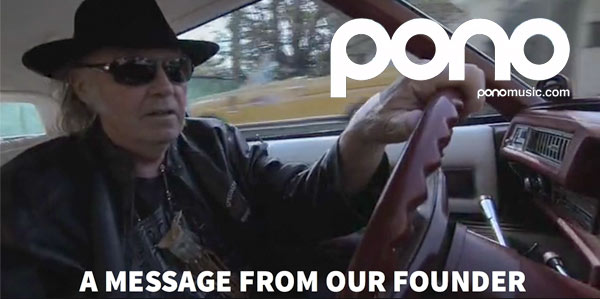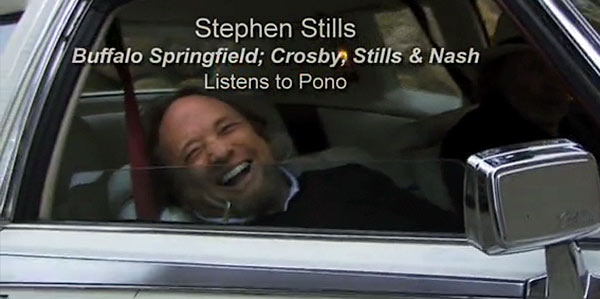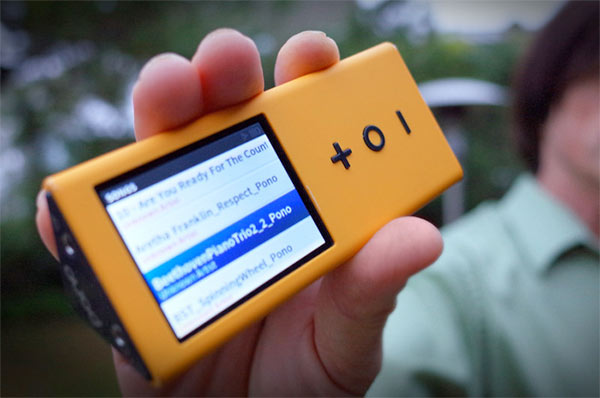What Do Rock Stars Hear? Selling the Pono Message
Rock Stars Can’t Hear: Selling the Pono Message
The feeding frenzy behind Neil Young’s Pono Kickstarter campaign continues today. When I looked yesterday morning, there was just over $15,000 pledged…by last evening, the amount had met the $800,000 goal and this morning they had crashed through $1,500,000. And there’s still 34 days to go until the campaign ends!
So just what does it take to introduce a new high-quality or high-resolution piece of hardware and an “ecosystem” to support it? Apparently, it takes around 50 heavyweight musicians, singer/songwriters, record company executives and a comedian/musician. That’s how many individuals are included in the 11’47” promotional video that can be found on the Ponomusic.com site AND Kickstarter page.
I personally think it’s overkill, but it sure seems to be working. The segment is titled “A Message From Our Founder”, but it takes almost 5 minutes and over 35 individual artist testimonials before Neil Young gives an “on-the-road” pitch (he’s driving one of his vintage cars) for music fans to join in their campaign for “better audio”. Besides being a major analog recording fanatic and quasi-audiophile, Neil owns a great classic car collection and he uses a 70s era Cadillac throughout the video.
Figure 1 – Stephen Stills listens enthusiastically in the passenger seat of the Cadillac.
And he uses that same car and another (I think it’s a vintage 60s Mercury…but don’t quote me on that) classic to demonstrate the new Pono system to his rock star friends. Yes, the deluge of artist endorsements included on the video experienced Neil’s exciting new hardware and high-quality tracks in the front seat of an automobile. Am I the only one that thinks this might have required a better playback system than you get in a car?
I mean what sort of meaningful evaluation can be accomplished in the front seat of a 30-year car parked in the lot behind the LA Convention center. It makes sense in some sense. That’s where the celebrity musicians are gathered (it must have been the NAMM Show) and it’s therefore easy to corral them into a car for a few minutes and then capture their reaction on a cheap video camera (the quality of the videos are pretty terrible).
The talent list includes Sting, Bruce Springsteen, Norah Jones, Flea, James Taylor, Patti Smith, Dave Matthews, Beck, Marcus Mumford and lots more. Have you ever watched a talk show where celebrity actors are asked what they think of their movies…and they respond by saying, “I never watch my movies”. I think that must be what’s going on within the world of rock stars. They must not be listening to their own recordings or they wouldn’t say some of the things I heard.
It was a love fest for Neil from a bunch of his friends. After all, what do you think the celebs are going to say in front of him? I have no doubt that they enjoyed the music played back in the car, but I do have serious doubts about the quality of what they heard. I can only imagine what I would have said if invited into the front seat (I have met and chatted with Neil on more than one occasion…and one of the Gold DVDs that I have on my wall was my production of his “Rust Never Sleeps” project…I’m very proud of that).
Of course, all of the stars were thrilled that their fans won’t have to listen to the heavily compressed MP3s that have dominated portable music for decades. I’m good with that. But then they start saying that the new Pono sound approaches the quality of good old vinyl LPs. They lost me there. I honestly don’t think that any of the people displayed on the video have ever heard a real high-resolution audio experience.
Figure 2 – A prototype Pono music player.
I’m sure they have listened to a lot of music during their careers. But by their statements, all they really want is to get back to where we were when Neil Young was making hits back in the 70s. I applaud the awareness that he brings to the area of high-resolution audio but the message is being applied to a bygone era.
So what’s the deal? Basically, the Pono team has developed a really nice handheld player (developed in collaboration with Ayre Acoustics) that can drive a set of headphones and a home system (or car system!). It will retail for $399 and have the ability to play just about any file type up to 192 kHz/24-bits (sorry…no DSD). It comes with 128 GB of built in storage and is expandable with additional SD cards.
And then there’s the Ponomusic.com website where you’ll be able to purchase the “high-resolution music” provided by the major labels and select independents. I went back and doubled checked their site and the video message. The content that will be available through their “ecosystem” is the same stuff that UMG, SONY and WB are making available to HDtracks and other high-quality digital music download sites. That came as a surprise…I figured with Neil’s pull and his connections to other musicians that he would be able to get more and better content for his site. Not so. You’ll be able to buy uncompressed transfers of standard definition classic albums put into excessively large bit buckets. The sound quality will be hit or miss depending on the original production values…but there’s not going to any real high-resolution tracks available. Too bad. I was really hoping for the real deal.
This is nothing more than the overhyped “Geek” and “Pulse” DACs that Light Harmonic successfully “pre sold” through Kickstarter and Indiegogo. The Pono player is just another piece of untested piece of equipment and yet pre sells a million dollars worth to anxious audio consumers.
And in the FAQ section of the Ponomusic site, it says that high-resolution files that you already have will play in the Pono music player BUT it doesn’t say anything about music downloaded from Pono being able to play in any other device. There’s a tremendous fear among audiophiles that their “ecosystem” will be closed and subject to DRM (digital rights management). By avoiding the question on the site, they’ve left it open to interpretation. We’ll have to wait and see on that one.




Finally, the record labels and musicians will finally gain back their stream of revenue from record sales! It is, as they say, an eco-system. An eco-system based on the original concept of the record industry that labels need to be compensated for their investment and the musicians get their royalties. It worked so well for so many years until the dreaded MP-3 took it all away. This is an MP-3 slam and there is nothing wrong with it. The record executives love it and the musicians (especially the old farts) are dreaming of the day they can stop touring incessantly to make up for the lost stream of royalty revenue. Oh I see, that’s why we didn’t see any Joe Schmoes driving around with old Neil and give their opinion in the video. Great marketing, but as Mark says, it’s nothing new folks. I applaud the motivation. It’s genuine and I respect the desire to get people (especially young folks) to appreciate better sound quality. Hopefully it’s a stepping stone for musicians and labels to recognize the need to support higher resolution recording methods. It’s hard not to shoot it full of holes, but it recognizes what we all want. Better sound.
Mark, you need star power like that to get your message across. Maybe Pono will have to pony up when it comes to explaining that their “high resolution” methods are nothing new. Maybe this is an opportunity for you!
I hope so.
I’m sure a bunch of 60 year old men who have been exposed to ear splitting sound levels (over a period of decades in some cases- I mean, Stills played Woodstock!) can make a solid, dependable judgment of the quality of source material based on hearing them over a car sound system. I don’t understand the skepticism…
Naaa…you think?
A few comments:
I’ve got to agree with Matt’s post. Maybe Neil and his friends high profile can reach a wider audience. I also never considered the benefit to the artists and music business. Regarding the files themselves, there is a statement in their FAQ section that says that the files will be in FLAC format and will playback on compatible devices – I asked for a little more detail but I do believe that the files will playback on our systems. Finally, somewhere in Neil’s comments / posts, he said that his offerings would be from artist approved masters. That’s not exactly a specification…
Oh, yeah – I’m not sure I would use Steve Stills to verify sound quality!
Artist approved masters simply means that the same masters that were used for the CDs were used for the “HD” versions. I’m not holding my breath.
The only thing those musicians could hear when they sat down in Neil’s car was the sound of money [cha-ching] — and I don’t blame them.
If the sound quality is better than itunes (and it has gotta be), then this will be a boon for them. If I’m feelin’ too anxious to wait for my cd in the mail, I might even patronize them.
if you’re really after the truth you should stop making comments about artists such as “I doubt if any of those people have ever heard hi-rez audio.” Really? Where do you think hi-rez audio comes from? What an arrogant, ignorant statement.
I make statements like that because I believe it’s true. Why else would Neil have to demonstrate it to all of his musicians in his video?
I’ve worked and been in studios my entire professional life and know what goes on with regards to formats and fidelity. Commercial music by the usual rock stars isn’t about “high-resolution” audio…they’re trying to make hit records. And more power to them.
When I played real high-resolution audio in my studio for Trent Resnor, Five for Fighting, Jackson Browne, Willie Nelson, Paul Williams, Todd Rundgren and Jennifer Warnes, they all turned to me and told me that they had never heard sound like this. The late Eric Lowen of Lowen and Navarro called me as he was suffering through the last months of ALS and told me that he finally got a chance to hear the recording that I did with him…he was overcome with emotion. This was his reaction after spending 20 years making records.
Different productions have different production techniques AND different targets. High-resolution audio doesn’t come from the major labels.